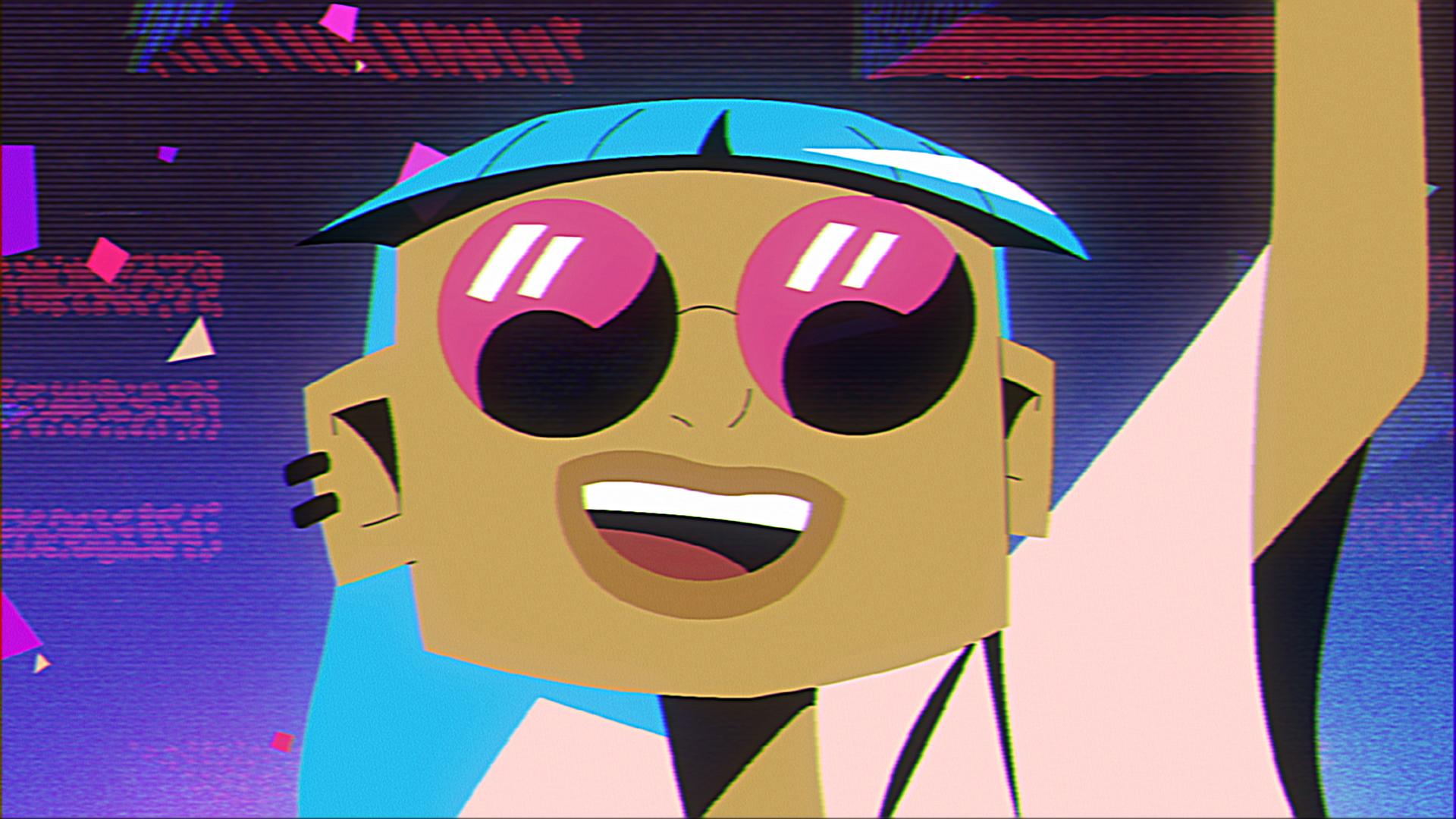
Shorts are some of our favorite things to watch at film festivals and SXSW is no exception. Watching Nuevo Rico is like being immersed in a baptism of ultra vivid hues, hyper stylized animation, and a deep love for Puerto Rico.
Premiering at SXSW, Nuevo Rico tells the story of a brother and sister that “stumble upon a celestial secret that changes their lives forever and propels them into Reggaetón stardom, but they soon discover that their newfound fame comes at a deep price.”
We had the chance to chat with director Kristian Mercado on Nuevo Rico, storytelling, and more!
*This interview has been edited for clarity and length.

Q: Where did the idea for you come from? And why did you decide on animation to tell the story?
KM: I think I’m a very medium agnostic person, you know. I don’t think stories have to be limited by medium. I’m not the type of person who thinks in terms of like, animation as a genre, but you know, it’s just a tool, right? So I feel like I learned a lot just from exploring all the different colors, you know. If like, one story can be live action, one story, it can be animation, and they all kind of tell you something, right? In the case of Nuevo Rico, Nuevo Rico is such a journey. And it’s so kind of out there. And it’s so embedded in this idea of Latinx futurism or the idea of trying to create a future world. The animation kind of naturally suited the product. As far as the origins of the idea, it kind of came out of me. I love what I get done, I had never seen cinematic language being connected to the reggaetón. and I felt like reggaetón travels so far and wide. Puerto Rico, it’s like a small island, you know, like, yet reggaetón, it’s become this musical phenomenon that has really taken over the music space in the world. It’s one of the most listened genres of music today, you know? Hip Hop has a lot of established vernacular and cinematic language, but reggaetón, it feels like a fresh face. There’s not a cinematic language connected to that. I just felt a strong connection to that, you know.
Q:How long did it take to make? It’s such a well animated piece!
KM: Oh, man, it took like a year from from scripting to completion was like a full year of work. You know, there’s a lot of back and forth, rewrites. We even reanimated re edited at some time. There’s was a lot of remixing.
Q: Did the pandemic get in the way of creating it, or did it change or shift the story at all?
KM: I think any piece of art created in the pandemic is definitely in some way, shape, or form gonna influence how we see the world or see art. So for me, it definitely, like, it changed the workflow. We had to do remote. Everything was remote. Everything was a lot of planning. I think the voice recording was the hardest part really, there’s not a smooth way to do that unless you’re in the in person. So we would have to record, but we wouldn’t really hear the quality of the sound until after so that that was a big change for us. That was possibly the hardest part of it all.
Q: One of the things I liked the most about the short is that’s a very saturated color and style.What was the process of creating that aesthetic like?
KM: Man, I mean, I like colors. I feel like I’m really big on psychedelics. I like the idea of finding spirituality. And that to some degree, I mean that in a big sense, spirituality can mean a lot of different things for a lot of different people. I think that there’s something about the richness of Puerto Rico and the colors of Puerto Rico and all of you know, Latin America, that kind of speaks to something. I think that it is just an impulse and part of the culture and kind of the boom of it all. I mean, a lot of that is just that Technicolor, hyper saturation. I like that. Like, when you see it, it almost like you can almost taste it, you know, and I wanted to make it feel that way.
Q: There are two siblings that star in Nuevo Rico, and their dynamic kind of changes throughout the short. Was there any like a real life inspirations while creating both of them/their dynamics?
KM: Oh, absolutely. Absolutely. I’m a big, big fan of Sidney Lumet. I feel like I’m the Puerto Rican bastard child of Sidney Lumet. What I mean by that is that Sidney Lumet once said, family is drama. Anytime you tell a story and their family, it heightens the stakes. For me, I wanted to show a spectrum of Puerto Rican identity within families, because that was what my family’s like growing up. We were a big spectrum, from my Abuelo to my Abuela, to my uncle to my aunts, you can see a whole wide spectrum of identities. It’s just interesting to me. Then, the idea that sometimes there’s forces beyond us that can kind of split or part families apart. I think that was kind of what interests me. You could tell that story a million ways, but I kind of wanted to speak to this idea of sometimes, you know, without getting too heavy on it, sometimes, money makes people funny. The idea that some of our problems are socio- economic. And I think I’m trying to speak to that. That families are torn apart by socio-economic things all the time, you know.
Q: What kind of message do you want to get across to audience, through the short?
KM: I think, honestly, there’s not a lot of media covering Puerto Ricans, you know. You can’t point to a sci fi, futuristic, speculative fiction short that has Puerto Ricans in it. Like, I couldn’t do that. And I tried. And I think that the idea that creating something that lets people feel seen to me, it’s a worthwhile endeavor. We all need to be trying to make that work happen. That’s our responsibility, we all share that in all communities. So it’s really important, I think, to just kind of create things that haven’t been seen. The cinematic language dictates how we see ourselves, it dictates how the world sees things, it defines a lot of culture. I think, you know, in America particularly, you know, American, the canon of American cinema is a powerful thing. If you’re part of it, that can literally change the world, it can change people’s perspectives. To me, I think people should just, you know, hopefully they walk away feeling seen.
Q: Do you see yourself extending this project to like a feature?
KM: Definitely has to be a feature, right? Like, it has to be. I think I gotta make that happen. I’m a fighter so I believe that Hollywood is a very un-diverse place that needs to be diversified. I think work that pushes boundaries, breaks down barriers and becomes undeniable. I think the pure joy of making that short has motivated me to try to push it to the future and let us be seen in a bigger platform. So I have a lot of aspirations for it. So I would, without a doubt say I want to see it as a feature and it will be a feature. It will happen. I’m gonna manifest it.
Q: Last question for you. What’s next?
KM: I’m always working on stuff. I’m really trying to break into the film and episodic space. I’ll be working on a new comedy special soon. I’m always building stuff. I want to kind of keep creating worlds and telling powerful stories and I do. I do plan to tell more stories as they get on and in the Latinx community, moving forward, and for the years to come.
Q: Do you plan on staying in that really, like, super saturated kind of space world or you want to go drama and that kind of lane?
KM: Honestly, I want to see some elves or some shit. I might fuck with elves. I want to make something with elves or wizards. You know. I mean, I do like drama a lot. I plan to explore that as well. I think Nuevo Rico has a little bit of drama in it too, you know, quite a bit. I know I’ll be exploring and very genre fluid. I think that there’s a lot of things in spaces that need to be played with and expanding our identity and cinema. There’s so much to do. And it’s not just something I myself can do, I think, multiple creators, we just need to be given platform and voices to create the work, you know.